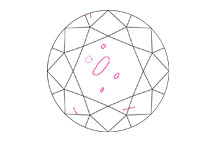THE 4Cs
The images and information below are courtesy of the Gemological Institute of America (GIA). They are one of the most recognized gemmological laboratories in the world when it comes to setting standards for identifying and grading loose diamonds and other coloured gemstones. The 4 “C’s” are Cut, Colour, Clarity, and Carat weight. These components are used to describe and grade diamonds as well as, with some variation to these “C’s”, colored gemstones.
The images and information below will help you to better understand the 4Cs of diamonds.
CUT

CLARITY

COLOUR

CARAT WEIGHT

CUT

The GIA Cut Scale ranges from Excellent to Poor when grading round brilliant diamonds.
A polished diamond’s beauty lies in its complex relationship with light. The magnificent display you see is made up of three attributes: Brightness is the combination of all white light reflecting from the surface and interior of a diamond. Fire describes the “flares” of color emitted from a diamond. Scintillation describes the pattern of light and dark areas and the sparkle you see when the diamond, the light, or the observer moves.
A diamond’s proportions affect its light performance, which in turn affects its beauty and overall appeal. Diamonds with fine proportions, symmetry, and polish optimize their interaction with light, and have increased brightness, fire, and scintillation.
Another component to cut is the shape or outline of the diamond. Round, Square, octagonal, pear, marquise, and oval are just a few.

CLARITY

The GIA Clarity Scale includes eleven clarity grades ranging from Flawless to I3.
Because diamonds form under tremendous heat and pressure, it is extremely rare to find a diamond that lacks any internal and external characteristics. These characteristics
are a by-product of its formation and help gemologists separate natural diamonds from synthetics and simulants, and identify individual stones.

COLOR

The GIA Color Scale extends from D (colorless) to Z (light yellow or brown).
Although many people think of gem quality diamonds as colorless, truly colorless diamonds are actually very rare. Most diamonds used in jewelry are nearly colorless with tints of yellow or brown.
Color grades are determined by comparing each diamond to a master set. Each letter grade represents a range of color and is a measure of how noticeable a color is.
Fluorescence Some diamonds can emit a visible light when exposed to ultraviolet radiation, but fluorescence is not a factor in determining color or clarity grades. However, a description of its strength and color is provided on GIA Reports as an additional identifying characteristic.

CARAT WEIGHT

One carat equals 200 milligrams in weight.
For diamonds under one carat, each carat is divided into 100 points – similar to pennies in a dollar. 0.75 ct. = 75 points, 1/2 ct. = 50 points.

How GIA Grades Your Diamond
GIA has been entrusted with grading some of the world’s most famous diamonds, and brings the same unmatched expertise to grading yours.
Independent and nonprofit, GIA is considered the final word on a diamond’s authenticity and quality. GIA developed the 4Cs and the International Diamond Grading SystemTM, the standard used around the globe.
GIA screens every gemstone to identify synthetics, simulants and known treatments. Expert gemologists examine each diamond under controlled lighting and viewing conditions, in order to provide the most rigorous assessments of a diamond’s 4Cs.
Every GIA grading report contains these assessments along with additional descriptive information and state-of-the-art security features. Buying a diamond is a momentous decision. GIA reports let you make it with confidence. Learn more at GIA.edu


